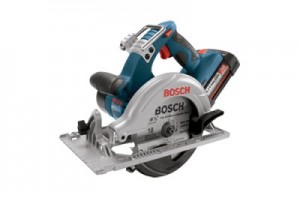One of the most common power tools you’ll find both on job sites and in home workshops is the circular saw. They can be used to cut a variety of materials, including wood, steel, masonry, ceramics and more. A standard saw will include basic components like a blade guard, and foot plate, and also allow for both bevel and depth adjustments. In order to ensure you buy the right circular saw for your needs, however, you’ll need to understand the other options available. Here’s a quick buying guide that will help you decide.
Motor Type
There are two basic designs for circular saws: sidewinder or inline saws, and worm drive saws. As the name would suggest, an inline saw has the motor located along the same axis as the blade. This allows them to be compact and lightweight. This is the traditional, most common design for circular saws and appropriate for most applications. The worm drive design places the motor at a right angle from the saw blade, which makes them longer than an inline saw, but also quieter. This also allows for increased torque transferred from the motor to the blade, which makes worm drive saws ideal for heavy-duty use.
Power Sources
Like many other power tools, you have the choice between a corded or cordless circular saw. A corded saw doesn’t require batteries or charging so you can start work anytime you’re near an outlet. They also tend to be better suited for cutting masonry, steel and other demanding applications. While your range is more limited, a reliable extension cord allows you to work pretty much anywhere. A cordless circular saw brings the convenience to work anywhere and there are some applications where a corded saw can’t reach. A cordless saw will be smaller than the corded version, which also allows them to work in confined areas. Batteries do need to be charged, however, and limit these circular saws to cutting wood only for the most part.
Features
There are a number of features that will set one circular saw apart from another. Your first consideration should be cutting power. This will be measured in amps for a corded saw, and volts for cordless options. The more amps and volts, the more cutting power this saw brings. Blade size, or capacity, determines how deep the saw will cut. Larger blades allow you to cut through thicker materials, but smaller blades make the saw lighter and easier to control. Electric brakes are an important feature for many. They allow the blade to stop in as little as 2 seconds, which is significantly faster than a circular saw without them. A spindle or shaft locks are only included on some circular saws, but make it far easier to change the blade. Laser guides are also available to help improve cutting accuracy.
Saw Blades
You’ll likely be purchasing blades separate from your circular saw, but you’ll need to ensure that the blade you choose is compatible with both your saw and your project. For soft wood, steel blades are an inexpensive choice. A high-speed steel blade is likely needed if you’re cutting harder materials, however. Carbide-tipped blades stay sharp for much longer than steel blades, even with harder materials. If you’re cutting ceramic tile, invest in a blade specifically designed for the job: tile-cutting blades. For masonry materials, masonry blades are needed to cut concrete, brick, and cinder block.
If you’re buying a circular saw for personal or professional use, come see us at Maxwell Supply in Tulsa, or call us at 918-836-8606.
